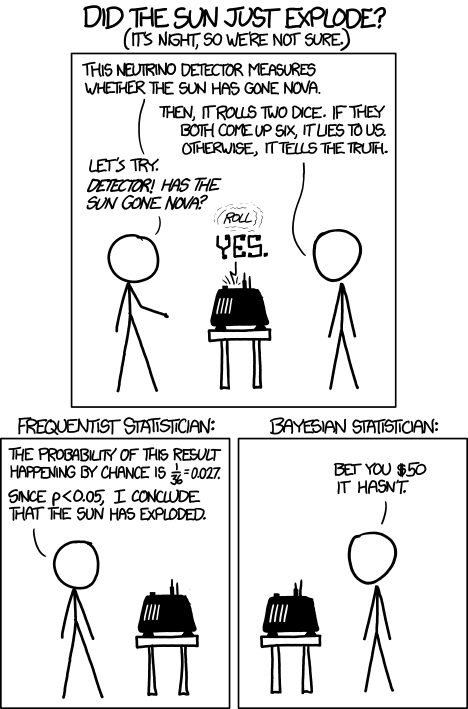Biostatistics 234 Applied Bayesian Analysis
Winter 2024 - Robert Weiss

News & Announcements:
- (2024) Everyone should attend the Thursday 2pm computer labs held in CHS 33-105. We won't hold the Noon lab.
- Course pages and information for enrolled students.
- Zoom meeting links for class, lab and office hours are on the course pages for students.
- Sept 29, 2014 New York Times article on Bayesian Statistics.
Class Schedule, Email Addresses, and Office Hours:
| Event | Time | Day | Room |
|---|---|---|---|
| Lecture | 1:00 - 2:50 | Tuesday | CHS 41-268 |
| Lecture | 1:00 - 1:50 | Thursday | CHS 41-268 |
| Computer Lab 1 weeks 1-9 | 2:00 - 2:50 | Thursday | CHS 41-268 |
| Prof | Robert Weiss | robweiss@ucla.edu | |
| Office Hours | 3:00 - 3:50 | Monday | Zoom |
| Office Hours | 2:00 - 2:50 | Wednesday | Zoom |
| Office Hours, Finals Week | 3:00 - 3:50 | Monday | Zoom |
| Teaching Assistant | Jay Xu | jayxu33@g.ucla.edu | |
| Office Hours | 12:00 - 12:50 | Tuesday | Zoom |
| Office Hours | 12:00 - 12:50 | Thursday | In Person, CHS A1-241 |
Syllabus and Textbook
2024 Syllabus and Course Information. Please see course pages and information for enrolled students.
Textbook: Gelman, Carlin, Stern, Dunson, Vehtari, Rubin (2013). Bayesian Data Analysis. 3rd edition, Chapman \& Hall/CRC Press. The closest thing to a Bible on Bayesian statistics.
Click for course pages and information for enrolled students.
General Information about Biostat 234 Bayesian Data Analysis
- This course is aimed at second year (or more advanced) Biostatistics masters students and Biostatistics doctoral students. Graduate (usually doctoral) students with a strong quantitative background from other departments are encouraged to enroll. A necessary prerequisite is a good background in linear regression as for example from Biostat 200B. Non-Biostat students will need additional mathematical or statistical training beyond the regression class such as exposure to hierarchical models, or Bayesian statistics, multiple statistics courses beyond regression/ANOVA, or for example a mathematical statistics course.
- Grading is based on homework, labs and data analysis projects.
- Course topics will include an overview of Bayesian philosophy, computation, data analysis, modeling and estimation. Emphasis will be on data modeling.
- Computing labs are an integral part of the course. Lecture examples are illustrated in the labs, and sample programs are presented for most of the computing discussed in class.
- Computing uses JAGS in R. We will need R-package R2jags and program JAGS installed. Advantages of JAGS over winbugs is the newer implementation, and it is easy to install on Apple systems as well as Windows machines.
- Rstudio<\a> is strongly recommended.
- Students from Biostatistics, Economics, Business, Education, Statistics and Epidemiology among other departments have successfully completed the course in previous years. Comfort with statistical tools such as likelihood and exposure to statistical computing will be helpful and possibly necessary preparation for the course. A previous regression course is necessary. Like many stat courses, the more statistics you already know, the more useful this course will be. In particular, exposure to logistic regression and random effects models will be very helpful.
- The lectures are based on notes which will be made available on the web. The notes will be the primary reading material.



